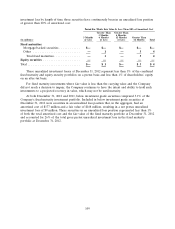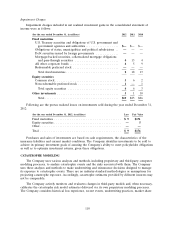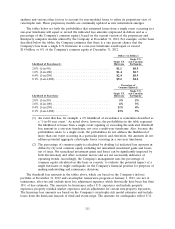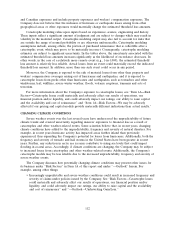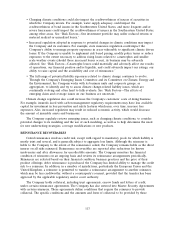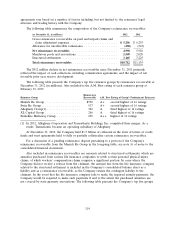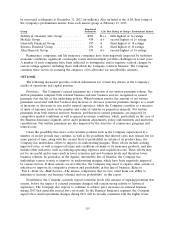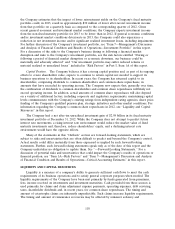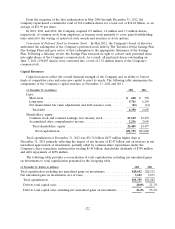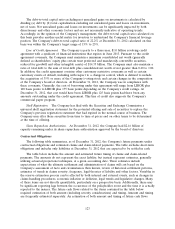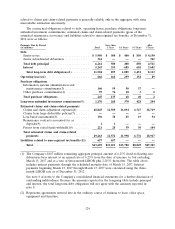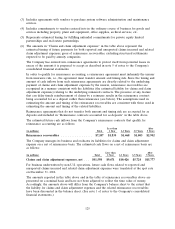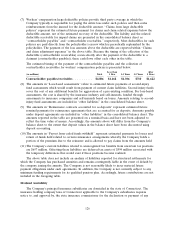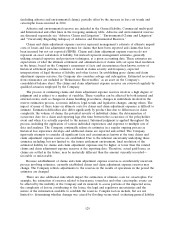Travelers 2012 Annual Report Download - page 131
Download and view the complete annual report
Please find page 131 of the 2012 Travelers annual report below. You can navigate through the pages in the report by either clicking on the pages listed below, or by using the keyword search tool below to find specific information within the annual report.reinsurance coverage disputes. Additionally, the variability of asbestos-related claim payments, as well
as the volatility of potential judgments and settlements arising out of litigation, may also result in
increased liquidity requirements. It is the opinion of the Company’s management that the Company’s
future liquidity needs will be adequately met from all of the above sources.
At December 31, 2012, total cash and short-term invested assets aggregating $2.03 billion and
having a weighted average maturity of 76 days were held in the United States by the holding company.
These assets are sufficient to meet the holding company’s current liquidity requirements and are in
excess of the Company’s minimum target level, comprising the Company’s estimated annual pretax
interest expense and common shareholder dividends, and currently totaling approximately $1.1 billion.
These liquidity requirements primarily include shareholder dividends, debt service and contributions to
its qualified domestic pension plan from time to time.
The holding company is not dependent on dividends or other forms of repatriation from its foreign
operations to support its liquidity needs. U.S. income taxes have not been recognized on $755 million
of the Company’s foreign operations’ undistributed earnings as of December 31, 2012, as such earnings
are intended to be permanently reinvested in those operations. Furthermore, taxes paid to foreign
governments on these earnings may be used as credits against the U.S. tax on dividend distributions if
such earnings were to be distributed to the holding company. The amount of undistributed earnings
from foreign operations and related taxes on those undistributed earnings were not material to the
Company’s financial position or liquidity at December 31, 2012.
The Company has a shelf registration statement with the Securities and Exchange Commission
which permits it to issue securities from time to time. The Company also has a $1.0 billion line of
credit facility with a syndicate of financial institutions that expires in June 2013. This line of credit also
supports the Company’s $800 million commercial paper program, of which $100 million was
outstanding at December 31, 2012. The Company is not reliant on its commercial paper program to
meet its operating cash flow needs.
The Company currently utilizes uncollateralized letters of credit issued by major banks with an
aggregate limit of approximately $392 million to provide much of the capital needed to support its
obligations at Lloyd’s. If uncollateralized letters of credit are not available at a reasonable price or at
all in the future, the Company can collateralize these letters of credit or may have to seek alternative
means of supporting its obligations at Lloyd’s, which could include utilizing holding company funds on
hand.
Operating Activities
Net cash flows provided by operating activities were $3.23 billion, $2.17 billion and $3.05 billion in
2012, 2011 and 2010, respectively. Cash flows in 2012 primarily reflected a decrease in losses paid
related to catastrophes, a lower level of paid losses related to asbestos claims and operations in runoff
and a higher level of collected premiums, partially offset by an increase in paid losses related to
non-catastrophe ongoing business (including the impact of increased loss costs). Cash flows in 2011
reflected an increase in losses paid related to catastrophes and ongoing business (including the impact
of increased loss costs), a higher level of contributions to the Company’s qualified domestic pension
plan and lower receipts related to net investment income as compared with 2010. These factors were
partially offset by a higher level of collected premiums, a lower level of paid operating expenses and a
lower level of paid losses related to asbestos claims and operations in runoff. In the years ended
December 31, 2012, 2011 and 2010, the Company contributed $217 million, $185 million and
$35 million, respectively, to its qualified domestic pension plan.
119


